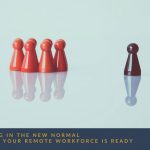
Out With the Old, In With the New
The executives you hear parroting the statement, “Things are finally getting back to the way they used to be,” aren’t noticing the ground shifting beneath them. Things are changing, but they aren’t going backward. They are evolving.
Sure, we can always learn from the past, but forcing old paradigms like office attendance without a purpose feels as antiquated as punching a time card or hoping a water cooler will become a cultural hotspot. The pandemic was a generation-changing experience and praying for a return to the way it used to be is just lazy thinking.
The Shift from Balance to Harmony
Work-life harmony broadens the perspective beyond the classic work-life balance, advocating for an enriching work-personal life experience that entwines seamlessly. It advocates hiring passionate individuals whose work is a seamless extension of their interests and long-term aspirations, thereby creating an ecosystem that thrives on mutual enrichment. It also means a transition in management and ecosystems. The following are four key changes making Work-Life Harmony a reality:
- Digital Transformation
- Generational Psychological & Management Shifts
- Transparency
Let’s dive deeper into these game-changing developments.
- Digital Transformation and Its Impact
The digital transformation of the workspace has made remote work and flexible scheduling the new normal, replacing the rigid 9-to-5 routine. This shift allows for autonomy but also blurs work-life boundaries. Organizations are re-evaluating their operational strategies, emphasizing KPIs over desk time. The key here isn’t technology but adapting management styles to focus on outcomes and maintain employee well-being in an “everywhere office.”
Employees, correspondingly, bear the responsibility to manage this freedom. They must produce measurable results, stay available for collaboration, and communicate transparently. Strategies like flexible work hours and unlimited PTO are part of this adaptation, focusing on high performers and fostering mental health.
Today we’ve already proven we have the technology to manage a remote workforce. What we lack are the management processes. The conventional notion of work-life balance, with its sharp distinction between work and personal life, isn’t the right mindset.. A new phrase to consider is work-life harmony – an integrated, fulfilling work and personal experience.
- Generational Psychological & Management Shifts
The shift from work-life balance to work-life harmony isn’t solely due to technological advances or new management strategies. It’s deeply rooted in generational changes, particularly among Millennials and Gen Z, who see work as not just a paycheck, but an extension of their identity and a vehicle for impact.
However, it’s not just a mindset shift among younger workers; it’s also about who is now in charge. Today’s managers are often Millennials who share these attitudes, and they’re shaping workplaces to reflect their own values, such as finding meaning in work.
In essence, the move towards work-life harmony is driven by a dual force: the evolving perspectives of younger generations and the rise of Millennial leadership. Together, they’re transforming how we understand and approach our work-life dynamics.
- Transparency
The hybrid work model demands a greater degree of transparency and self-discipline. Clear communication about availability, time management techniques like the Pomodoro Technique, and dedicated home workspaces are vital. Respecting employees’ personal time becomes paramount, ensuring they are not “on call” 24/7.
How Work-Life Harmony is Easier Achieved With a Trusted Advisor
Even before the pandemic put work-life balance in the spotlight, forward-thinking leaders were already harnessing the benefits of a harmonious work environment. In this context, a trusted advisor becomes indispensable, serving as a catalyst for transformation.
A Proxxy helps leaders recognize work-life harmony as more than just a buzzword—it’s a strategic advantage. This foresight has led to several pivotal organizational changes:
- Accessibility: Enables seamless, round-the-clock communication, ensuring that insights aren’t confined to traditional office hours.
- Talent Attraction: A culture of harmony naturally attracts top talent, who seek more than just financial compensation.
- Data-Driven Insights: Utilizes digital tools to provide real-time, actionable data, shifting the focus from intuition to evidence-based decisions.
- Cost Efficiency: A streamlined, harmonious work environment leads to reduced operational costs, which ultimately benefits clients.
- Results Over Politics: By focusing on delivery and outcomes, petty office politics are set aside, elevating the quality of work.
A trusted advisor collaborates closely with top leadership, transitioning work-life harmony from an abstract concept into an organizational practice. By building trust and mutual understanding, processes are refined to allow for a work environment where both employees and the organization flourish.
Final Thoughts
The transition from the conventional balance to work-life harmony isn’t merely a semantic shift – it’s a radical alteration to the fundamental perceptions of our working and personal lives. To keep up with this change, it’s crucial to meticulously monitor KPIs while also engaging in activities that inspire passion and joy. It’s important to remember that achieving harmony between work and life is no longer just a privilege, but a necessity for a truly fulfilling life. The time to incorporate this innovative approach is now, on the edge of a remarkably integrated future.




